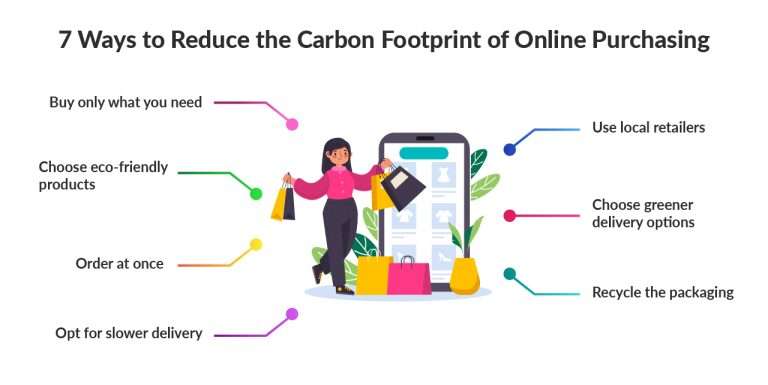In an age where convenience reigns supreme, online shopping has become the norm for many. With just a few clicks, we can have anything from groceries to clothing delivered right to our doorstep. But as we revel in this newfound ease, it’s crucial to consider the hidden cost of our digital purchases.
While it may seem that online shopping is a more environmentally friendly option than traditional brick-and-mortar stores, the truth is far more complex. In fact, carbon emissions associated with e-commerce logistics in the world’s largest urban areas are projected to reach a staggering 25 million metric tons of CO2 by 2030. As tempting as it may be to succumb to the allure of online shopping, we must all take responsibility for reducing our environmental footprint and making more sustainable choices.
Let’s understand online shopping’s impact on the environment and 7 actionable steps to reduce digital footprint.
The Problem with Packaging
Online shopping has led to an alarming increase in packaging waste. The Ellen MacArthur Foundation reports that global packaging waste is expected to grow from 311 million tons to 377 million tons by 2025, with online shopping playing a significant role in this growth. In the United States alone, an estimated 165 billion packages are shipped each year, resulting in millions of tons of packaging waste that ultimately finds its way into landfills. This waste contributes to pollution and climate change, highlighting the need for individuals and businesses to be mindful of their packaging choices and work towards more sustainable solutions.
The Transportation Dilemma
While online shopping can reduce carbon emissions from transportation for customers who live far from stores, the delivery process itself can contribute significantly to carbon emissions. The World Economic Forum reports that delivery trucks account for up to 20% of urban traffic in cities. Failed delivery attempts, which often require a second or third attempt, result in additional trips and emissions. Moreover, customers who opt for speedy delivery or purchase single items from different retailers further increase the carbon footprint of online shopping.
The Returns Conundrum
The ease of online shopping has led to a surge in return rates, which has a significant impact on the environment. Optoro reports that the United States generates around 9 billion pounds of returned goods annually, translating to roughly 15 million tons of carbon emissions from transportation and disposal. These returns are responsible for generating 5 billion pounds of greenhouse gases each year, equivalent to the emissions generated by 5.1 million cars annually.
The Landfill Legacy
When returned items are not resold, they often end up in landfills, where they release harmful greenhouse gases as they decompose. Approximately 9 billion pounds of returned goods end up in landfills each year, wasting valuable resources that were used to produce the items. To mitigate the environmental impact of returns, consumers must be more mindful of their purchases, and retailers must implement sustainable return policies, such as finding ways to resell or repurpose returned items.
While online shopping offers unparalleled convenience and accessibility, we must acknowledge its hidden environmental costs. To reduce the carbon footprint of online shopping, we must all take responsibility and make sustainable choices, such as carefully considering our purchases and supporting retailers with sustainable return policies. By doing so, we can help create a more environmentally conscious and sustainable future.
7 Ways to Reduce the Carbon Footprint of Online Purchasing

1. Buy only what you need: Before placing an order, take pause. Do you really need what you’re about to order? Resist impulse purchases and plan ahead to reduce the number of orders you place.
2. Choose eco-friendly products: Seek out products made from sustainable materials, use minimal packaging, or have eco-friendly certifications.
3. Order at once: Consolidate your purchases into one order to reduce the number of deliveries and associated emissions.
4. Opt for slower delivery: When available, choose slower shipping options, as they often combine your package with other deliveries, using less fuel.
5. Use local retailers: Whenever possible, buy from local retailers to reduce the distance your package must travel.
6. Choose greener delivery options: Support delivery companies committed to reducing their emissions, such as those using electric vehicles or bicycles for delivery.
7. Recycle the packaging: Many packaging materials can be recycled, so be sure to dispose of them properly.


